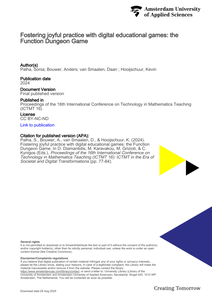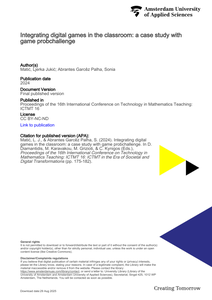Dit proefschrift presenteert twee theoretische kaders voor het ontwerpen van games en beschrijft hoe game designers deze kunnen inzetten om het game ontwerpproces te stroomlijnen. Er bestaan op dit moment meerdere ontwerptheorie¨en voor games, maar geen enkele kan rekenen op een breed draagvlak binnen de game industrie. Vooral academische ontwerptheorie¨en hebben regelmatig een slechte reputatie. Het eerste kader dat game designers inzicht biedt in spelregels en hun werking heet Machinations en maakt gebruik van dynamische, interactieve diagrammen. Het tweede theoretische kader van dit proefschrift, Mission/Space, richt zich op level-ontwerp en spelmechanismen die de voortgang van een speler bepalen. In tegenstelling tot bestaande modellen voor level-ontwerp, bouwt Mission/Space voort op het idee dat er in een level twee verschillende structuren bestaan. Mission-diagrammen worden gebruikt om de structuur van taken en uitdagingen voor de speler te formaliseren, terwijl space-diagrammen de ruimtelijke constructie formaliseren. Beide constructies zijn aan elkaar gerelateerd, maar zijn niet hetzelfde. De verschillende wijzen waarop missies geprojecteerd kunnen worden op een bepaalde ruimte speelt uiteindelijk een belangrijke rol in de totstandkoming van de spelervaring.
DOCUMENT

In order for techniques from Model Driven Engineering to be accepted at large by the game industry, it is critical that the effectiveness and efficiency of these techniques are proven for game development. There is no lack of game design models, but there is no model that has surfaced as an industry standard. Game designers are often reluctant to work with models: they argue these models do not help them design games and actually restrict their creativity. At the same time, the flexibility that model driven engineering allows seems a good fit for the fluidity of the game design process, while clearly defined, generic models can be used to develop automated design tools that increase the development’s efficiency.
DOCUMENT

This paper presents the latest version of the Machinations framework. This framework uses diagrams to represent the flow of tangible and abstract resources through a game. This flow represents the mechanics that make up a game’s interbal economy and has a large impact on the emergent gameplay of most simulation games, strategy games and board games. This paper shows how Machinations diagrams can be used simulate and balance games before they are built.
DOCUMENT

Using game-based learning (GBL) has a proven potential to be an effective didactical method but it is not easy to implement in practice. Teachers find e.g. difficult to match a particular game dynamics and the curricular goals or to connect with the pedagogical models of particular games.In order to support student-teachers to develop pedagogical knowledge and skills to effectively apply this method we are developing a course about Game Based Pedagogy (GBP) for the teacher education program. This project is a Teaching Fellows Comenius (see (https://www.nro.nl/en/onderzoeksprogrammas/comeniusprogramma/toegekende-projecten).The development and implementation of the course follows a co-creation process in an interdisciplinary team involving high-school teachers, teacher educators and the Smart Education lab for Applied AI.In this workshop we present our first prototype of the course and invite the participants, through hands-on activities to explore some of the games, materials and examples that we developed. This workshop is intended for high school teachers, teacher educators and anyone who is interested in integrating Game-Based Pedagogy into practice.
DOCUMENT

The use of games as interventions in the domain of health care is of-ten paired with evaluating the effects in randomized clinical trials. The iterative design and development process of games usually also involves an evaluation phase, aimed at identifying improvements for subsequent iterations. Since game design theory and theories from associated fields provide no unified framework for designing successful interventions, interpreting evaluation results and for-mulating improvements is complicated. This case study explores an approach of monitoring design decisions and corresponding theories throughout the design and development cycle, allowing evaluation results to be attributed to design decisions. Such an approach may allow the game design and development pro-cess to iterate the game more efficiently towards use in practice.3rd European Conference on Gaming and Playful Interaction in Health Care.
DOCUMENT

In this paper we present an educational digital game, Function Dungeon, that we developed for learning about functions in a playful way. Results from a pilot conducted with fourteen 13-year-old students in a school in the Netherlands show that the game can foster ‘joyful practice’. That is, students experience fun and sense of control while practicing mathematics. Findings from this study contribute to the development of knowledge about digital educational games and its potential to transform traditional practices in education.
DOCUMENT

© Springer International Publishing AG 2016. A serious game needs to combine a number of different aspects to help the end user in reaching the desired effects. This requires incorporating a broad range of different aspects in the design, stemming from a broad range of different fields of expertise. For designers, developers, researchers, and other stakeholders it is not straightforward how to organize the design and development process, to make sure that these aspects are properly addressed. In this chapter we will discuss a number of ways of organizing the design and development process and various models that support specific design decisions during this process, concluding with a discussion of design patterns for serious games.
DOCUMENT

This study furthers game-based learning for circular business model innovation (CBMI), the complex, dynamic process of designing business models according to the circular economy principles. The study explores how game-play in an educational setting affects learning progress on the level of business model elements and from the perspective of six learning categories. We experimented with two student groups using our game education package Re-Organise. All students first studied a reader and a game role description and then filled out a circular business model canvas and a learning reflection. The first group, i.e., the game group, updated the canvas and the reflection in an interactive tutorial after gameplay. The control group submitted their updated canvas and reflection directly after the interactive tutorial without playing the game. The results were analyzed using text-mining and qualitative methods such as word co-occurrence and sentiment polarity. The game group created richer business models (using more waste processing technologies) and reflections with stronger sentiments toward the learning experience. Our detailed study results (i.e., per business model element and learning category) enhance understanding of game-based learning for circular business model innovation while providing directions for improving serious games and accompanying educational packages.
MULTIFILE

This paper reports how a mathematics teacher uses a digital game for learning and teaching in the classroom. We utilize a case study approach to examine the pedagogical activities present in the lesson. The results of the study indicate that not all of the lesson objectives were met. Even though the teacher planned the lesson and the activities for the students, his lack of knowledge about gamebased pedagogy had an impact on the learning outcomes.
DOCUMENT

The research goal of this dissertation is to make configurational HRM usable for science and practice by developing a simulation model and serious game. These tools offer HRM professionals the opportunity to design a multiyear HRM configuration that shapes employee behaviour, while enabling HRM research to get access to a level of detail that was not achieved earlier, contributing to the current state of the art knowledge on strategic HRM. To shape employee behavior in such a way that it contributes to overarching organizational goals, organizations often deploy a set of human resource management (HRM) practices. If the set of individual HRM-practices is designed correctly, they amplify each other in shaping the desired behavior. However, while there is wide agreement on the importance of combining HRM-practices in a configuration that reflects the organizational strategy, we notice a lack of consensus on which HRM-practices need to be combined given a specific strategic goal and organizational starting point. Furthermore, we did not find an agreement on how to design HRM configurations that shape the desired employee behavior within organizations in multiple years. As a result, HRM professionals that design HRM configurations are left empty handed. While the configurational approach has the potential to provide new insight on how HRM shapes employees’ behavior, applying the configurational mode of theorizing to HRM remains challenging. We explain this challenge by the level of theoretical and practical detail that is needed, by the application of the holistic principle when studying HRM configurations, and due to methodological issues. Traditional methods do not align to the dynamic assumptions and the large number of variables included in configurational HRM. In this dissertation we pose that the time is ripe to unlock the deserved value of configurational HRM for theory and practice. We do so by specifying the underlying assumptions and dynamic implications of the configurational mode of theorizing in HRM, and by defining and adding the needed level of detail. In the current research, configurational HRM is made applicable with the use of a simulation model and serious game. -172- Five sequential steps are taken to make configurational HRM applicable. Firstly, key principles of configurational HRM are identified. Secondly, to ground the simulation we look at the manifestation of ideal type HRM configurations in theory and practice. Thirdly, we collect the solidified practical knowledge of HRM professionals on the alignment of HRM-practices. Fourthly, an initial simulation model is created and tested. And finally, we solidified the simulation model for practice and research by implementing it in a serious game for HRM professionals. Taking these five steps, we have specified configurational HRM to an unprecedented level of detail that allows us to address its complexity empirically and theoretically. We claim that with the results of this research we have opened the scientific and empirical “black box” of configurational HRM. Furthermore, the simulation model and serious game provides HRM professionals with a tool to design firm specific HRM configurations in an interactive and fun way. While prior studies did already acknowledge the importance of alignment when designing HRM, the simulation model and serious game specify the general concept of alignment to a level at which HRM professionals and researchers can start selecting, designing, implementing and researching HRM configurations. The tools provide HRM professionals with a method to grasp, maneuver through the complexity of, and explore the implementation of multi-year firm specific HRM.
MULTIFILE
